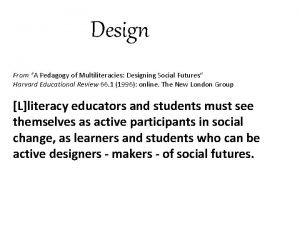Design From A Pedagogy of Multiliteracies Designing Social

![[W]e propose a metalanguage of multiliteracies based on the concept of "design. “ The [W]e propose a metalanguage of multiliteracies based on the concept of "design. “ The](https://slidetodoc.com/presentation_image/446e3cd511ccc8aaf578d2f9a79764dc/image-2.jpg)















- Slides: 17

Design From “A Pedagogy of Multiliteracies: Designing Social Futures” Harvard Educational Review 66. 1 (1996): online. The New London Group [L]literacy educators and students must see themselves as active participants in social change, as learners and students who can be active designers - makers - of social futures.
![We propose a metalanguage of multiliteracies based on the concept of design The [W]e propose a metalanguage of multiliteracies based on the concept of "design. “ The](https://slidetodoc.com/presentation_image/446e3cd511ccc8aaf578d2f9a79764dc/image-2.jpg)
[W]e propose a metalanguage of multiliteracies based on the concept of "design. “ The metalanguage of multiliteracies describes the elements of Design, not as rules, but as an heuristic that accounts for the infinite variability of different forms of meaning-making in relation to the cultures, the subcultures, or the layers of an individual's identity that these forms serve. At the same time, Designing restores human agency and cultural dynamism to the process of meaning-making. Every act of meaning both appropriates Available Designs and recreates in the Designing, thus producing new meaning as The Redesigned.

Designs of Meaning Available Designs: • Resources for meaning; Available Designs of meaning Designing: • The work performed on/with Available Designs in the semiotic process The Redesigned: • The resources that are reproduced and transformed

Multimodality: A Social Semiotic Approach to Contemporary Communication (2010) Gunther Kress For Kress, design goes beyond critique (or interpretation). He says: In an unstable social world with differing distributions of power, design offers a paradigm which keeps the insights offered by critique and turns them into means for action in the designer's interest, an interest focused on the future. In that context, design is an assertion of the individual's interest in participating appropriately in the social and communicational world; and an insistence on their capacity of shape their interests through the design of messages with the resources available to them in specific situations (22).

Design is prospective: a means of projecting an individual's interest into their world with the interest of effect in the future. It is the position taken by those who have become accustomed to produce (for You. Tube even if not in or for the school) and who disseminate their messages in and to a world which they address confidently (23).

Look at these images within the “image” of the Wedgewood cameo within the context of various approaches to design offered by our articles: Gallagher, Martin, Ma (Jason, Ashley, Michelle, and Netty) Julier (Andrew, Erin, Jeff, and Travis) Hum (Megan, Sarah, Jenn, Kendall) Hamilton (Anna, Julianna, Mandy, Tyreek) Ambient Visual Media Ecology (me, and only if we have time)

"Am I not a Man and a Brother? " Official Medallion and Motto of the British Society for Effecting the Abolition of the Slave Trade (1787) A Jasper-ware cameo of the Society's Motto, design and production by Josiah Wedgwood (1787)

Thomas Bewick, engraving, 1787 Anti-slavery petition, 1791 See http: //historyandsocialaction. blogspot. com/2014/04/did-thomas-bewick-designkneeling-slave. html

18 th century, oil on canvas

Working and middleclass women in Britain were involved in the anti-slavery campaign, too. They secured production of a ceramic brooch, with the caption 'Am I not a Woman and a Sister? '. The image of a chained and kneeling slave at right is the well-known symbol of abolitionism, first used by an English anti-slavery society in the 1780 s and later adopted by American abolitionists, as seen in the female slave image engraved in 1835 by Patrick Reason, "A Colored Young Man of the City of New York. " T

After the 1788 Regulation Act, the Brookes (also spelled Brooks) was allowed to carry 454 slaves, the approximate number shown in this illustration. However, in four earlier voyages (1781 -86), she carried from 609 to 740 slaves so crowding was much worse than shown here; for example, in her 1782 voyage with 609 enslaved Africans, there were 351 men, 127 women, 90 boys, and 41 girls crammed into its decks "Stowage of the British Slave Ship 'Brookes' under the Regulated Slave Trade, Act of 1788"; shows each deck and cross-sections of decks and "tight packing" of captives.

The Sydney Cove Medallion 1789

Circa 1835 Although the British Parliament abolished the Transatlantic Slave Trade in 1807, the slaves in British colonies were not freed until 1834. This kneeling figure of a black slave, with broken chains and manacles lying beside him, supports an open book on his raised knee. The book is inscribed with the words "Bless God/ Thank Britton/Me No Slave". The figure pays tribute to those who helped to free him. Circa 1820

AM I NOT A MAN AND BROTHER? AIR — Bride's Farewell. Am I not a man and brother? Ought I not, then, to be free? Sell me not to one another, Take not thus my liberty. Christ our Saviour, Died for me as well as thee. Am I not a man and brother? Have I not a soul to save? Oh, do not my spirit smother, Making me a wretched slave; God of mercy, Let me fill a freeman's grave! Yes, thou art a man and brother, Though thou long has groaned a slave, Bound with cruel cords and tether From the cradle to the grave! Yet the Saviour, yet the Saviour, Bled and died all souls to save. Yes, thou art a man and brother, Though we long have told thee nay; And are bound to aid each other, All along our pilgrim way Come and welcome, come and welcome, Join with us to praise and pray!

abolitionist-john-brown. blogspot. com/2012/02/standing-lincoln-kneeling-black-worship. html

Murder in Mississippi is an illustration for Look magazine created by Norman Rockwell. It concerns the 1964 murder of three young civil rights workers: James Chaney, Andrew Goodman, and Michael Schwerner, who were helping to register black voters in Mississippi. .

 A pedagogy of multiliteracies: designing social futures
A pedagogy of multiliteracies: designing social futures Maria__090915
Maria__090915 Janet grauberg
Janet grauberg Techno pedagogy
Techno pedagogy Public pedagogy definition
Public pedagogy definition Sport pedagogy definition
Sport pedagogy definition Andragogy vs pedagogy
Andragogy vs pedagogy Peda meaning in pedagogy
Peda meaning in pedagogy Example of equity pedagogy
Example of equity pedagogy Georgia tapp program
Georgia tapp program Gender responsive pedagogy
Gender responsive pedagogy How to pronounce merit
How to pronounce merit What is pedagogical analysis
What is pedagogical analysis Gradual release of responsibility pedagogy
Gradual release of responsibility pedagogy Paradigm shift from pedagogy to andragogy to heutagogy ppt
Paradigm shift from pedagogy to andragogy to heutagogy ppt Education scotland play pedagogy toolkit
Education scotland play pedagogy toolkit Divine pedagogy
Divine pedagogy Humanising pedagogy
Humanising pedagogy
































